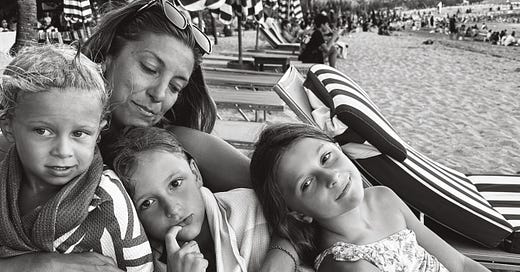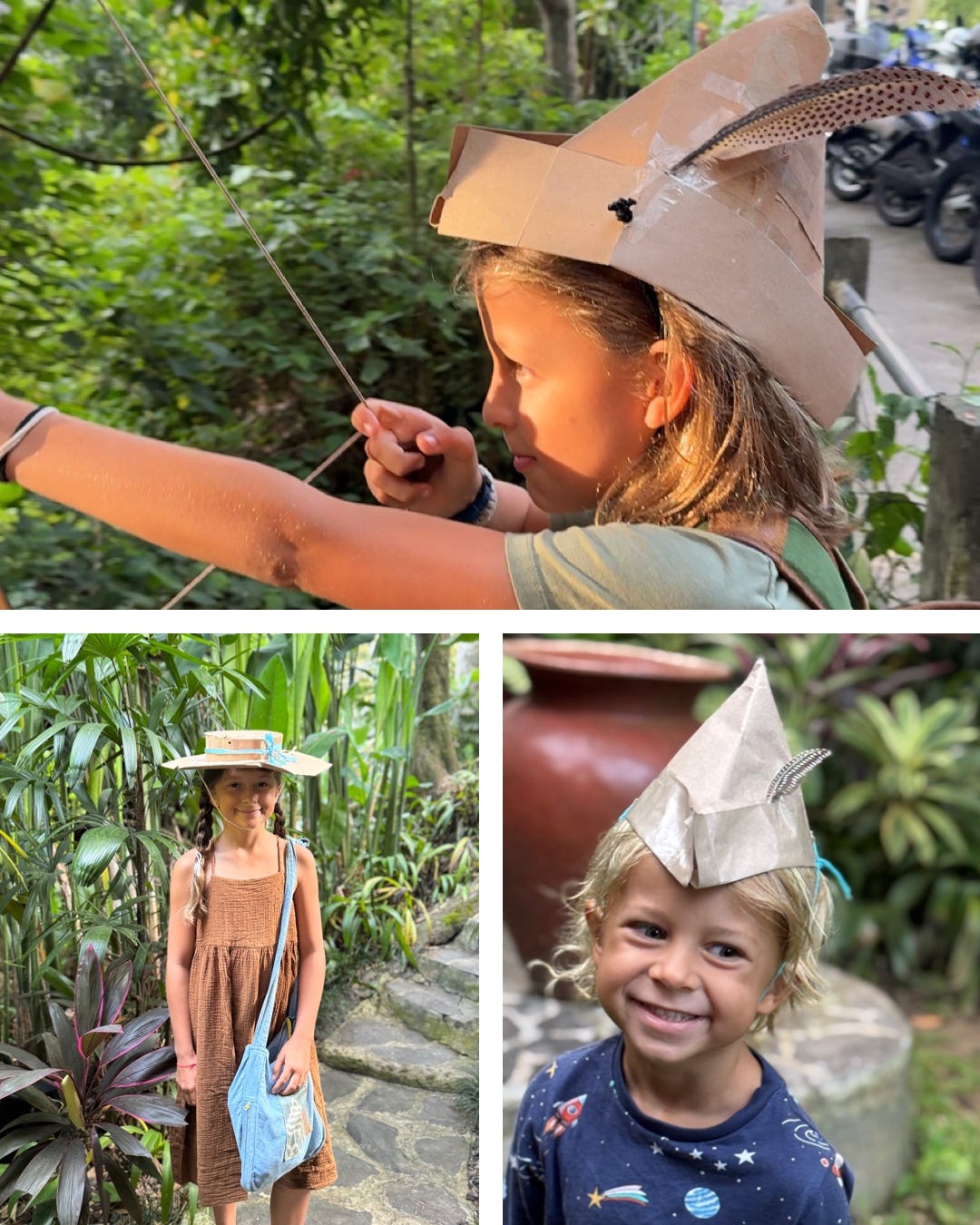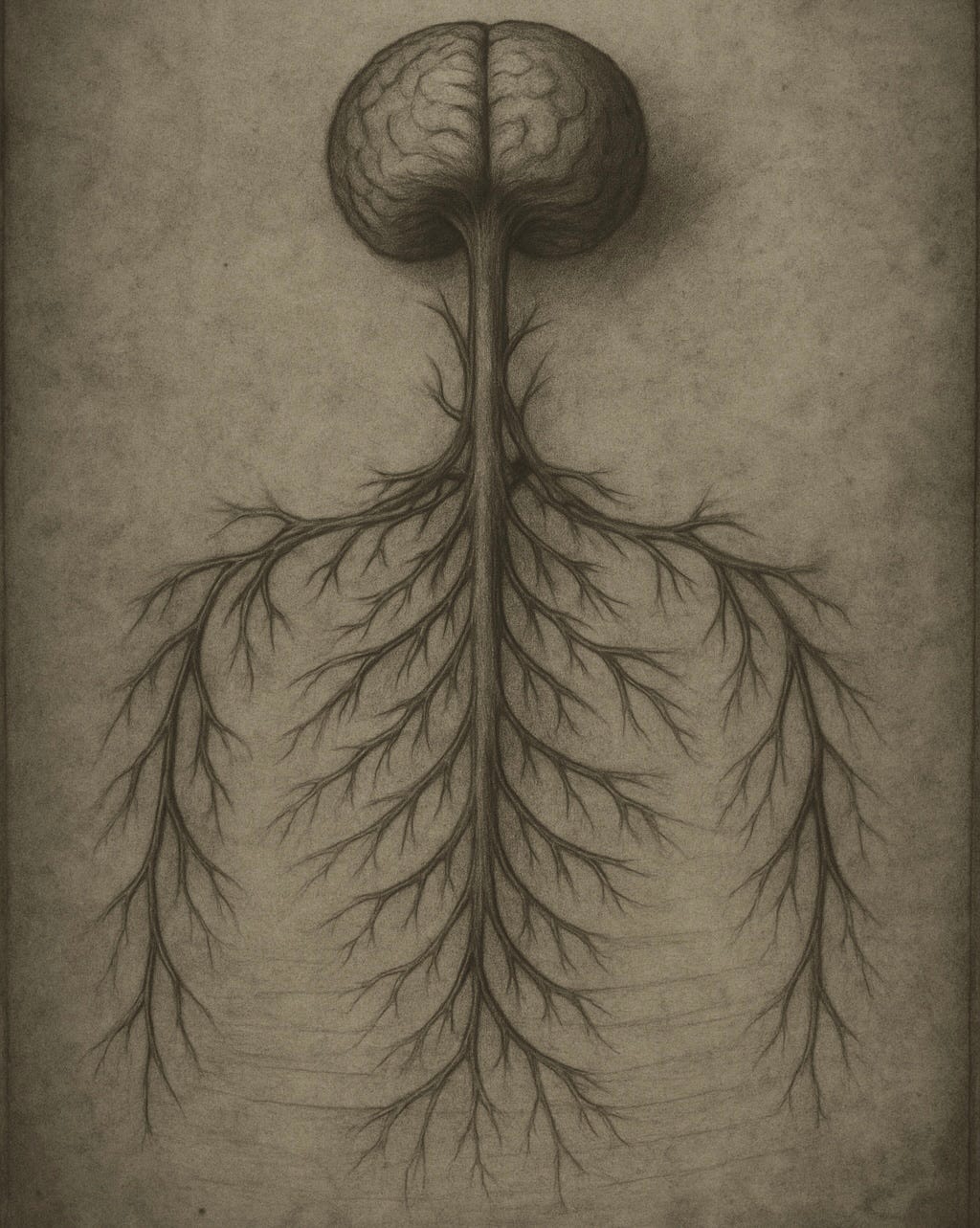I'm Tired of All the Tools
Maybe we don’t need more coping strategies for ourselves or our children. Maybe we just need lives we don’t have to recover from or "cope" with...
I would be lying if I told you everything is going swimmingly over here with all three of my children. We’ve been having some MOMENTS with Kai (my middle boy) lately. He’s in that developmental phase where he’s transitioning out of a world ruled by tactile, sensory exploration and into the more complex territory of emotional and social awareness.
It’s been… interesting.
If you read his chart, it’s all earth with just a touch of air. He’s solid and stubborn like a rock—grounded, methodical, brilliant—but with very little emotional fluidity. While I operate almost entirely from a space of feeling, Kai moves through life primarily from his mind.
Holding space for someone who doesn’t experience emotions in the sensitive, nuanced way I do—without making him wrong or trying to mold him into a more emotionally expressive version of himself—has been a journey. It would be so much easier if he were more empathetic, but he simply isn’t wired that way. And that’s not a flaw—it just means the path to helping him honor other people’s feelings and make wise choices looks different.
The Moment
The other day, in one of those moments, he got extremely wound up. Not because he was being bad or selfish—he just couldn’t make sense of what was happening. I found myself snapping: “Kai, you need to get it together. Do whatever you need to do right now to regulate, because this ain’t it.”
I said it louder than I wish I had. Some may say I yelled.
Immediately, I felt the sting of those words. I dropped to my knees and wrapped him in a long, grounding hug—one of those minute-long ones that feels like a lifetime. I apologized and explained that it isn’t his job to regulate his own nervous system, especially when mine is off-center.
I was stressed that day—doing work I didn’t want to be doing, feeling overwhelmed. I’d spent hours on backend admin tasks that do not spark joy. While I’ve built a life that rarely requires me to do that kind of work, this was one of those rare days. And I was not vibing with it. And everyone could feel it.
That moment has been sitting with me all week.
Regulation Isn’t Their Job
So much of what I see in the world right now, especially online obviously because of my algorithm, is about teaching kids how to regulate their emotions. There are parenting books and courses on raising more mindful children. Meditation apps to help them cope with anxiety. Breath techniques for stressed-out kids. A whole wave of gentle parenting that includes “teaching regulation” as part of the curriculum.
Let me be clear:
I LOVE all of that. I really and genuinely do!
I love giving our children tools. I love yoga for kids. I love breathwork. I love anything that reconnects children to their bodies and inner worlds.
And… in the same breath, it makes me a little sad that we think we have to.
Because:
It’s not actually the child’s job to learn regulation. It’s ours.
What They Feel Is What They Learn
In early childhood, a child’s nervous system develops in direct response to the nervous system of their primary caregiver—most often, the mother. Their brains and bodies literally mirror our breath, tone, stress responses, and capacity to stay grounded when things get intense.
Scientifically, this is called co-regulation. Spiritually, it’s called transmission. Energetically, it’s the feeling of security.
If my system is well, my child learns what wellness feels like.
If my system is overwhelmed, chaotic, or stressed, my child learns the world is unpredictable and unsafe.
Even if I say all the “right” words… it doesn’t matter. We can talk the talk all day and try to teach by explaining, but here’s the thing:
Our children don’t learn from what we say. They learn from what they FEEL in our presence.
Their brains aren’t yet wired to interpret our advice. They’re wired for sensation. They absorb the emotional frequency of the room—of their caregivers. They feel everything. And from that felt sense, they build their inner worlds.
This is why there’s no faking it.
Not even a perfectly calm tone can override a nervous system that is dysregulated, an energy field that is unfulfilled, or a body that is wound up in worry and fear.
The Mother
In many ancient traditions, the mother is understood to be the center of the family—the anchor. She keeps the rhythm and overall wellbeing. When she is well tended to, the whole family can feel that safe sense of calm and softness. When she is depleted or untended, things begin to unravel. The old saying “When Mama ain’t happy, ain’t nobody happy” comes to mind… My grandmother had a magnet that said that. I always felt it, but now I get it.
This is not about putting more pressure on mamas or caregivers—absolutely not. As a mother myself, that’s the last thing I’d want to do. I don’t share this to invoke shame or guilt. I’m not encouraging you to carry even one ounce more than you already are. In fact, I’m inviting you to consider carrying less.
Even in ancient cultures, this understanding wasn’t meant to burden mothers—but to honor their influence, to ensure they were resourced and supported, to call in the village at all costs. We are not meant to carry it all alone. But we are meant to organize our lives around being well and regulated human beings—because no child should have to learn how to breathe themselves back to safety.
They should feel safe and regulated merely by being with us.
Regulation Through Alignment
One of the things I deeply cherish about Green School—the school my children attend here in Bali—is that they don’t allow store-bought costumes for any dress-up days, which I’ve really grown to cherish. Today was Book Day. The night before, we gathered around after dinner to talk about who they wanted to be.
Kai’s top pick: Robin Hood.
Willow’s: Anne of Green Gables.
Both choices felt perfectly appointed—like their souls knew exactly who to channel.
We scrounged the house for cardboard and paper bags to craft their accessories. There weren’t many supplies to work with, and yet we were entirely un-phased. If anything, it made us more thoughtful, creative, and giggly. As I helped them piece together their looks, I thought about how much time, energy, and money I used to pour into dress-up days. Don’t get me wrong—there was definitely some pleasure in it. But the hours I spent scrolling online, wandering aisles at Target, obsessing over the details… it’s honestly a little embarrassing when I look back.
And here’s the thing:
It wasn’t the money or time that was the problem. It was that I was giving so much of myself to something I didn’t actually care about. I was devoting energy to something misaligned with who I am, what I value, and what truly matters to me (and our family). And because of that, I created unnecessary stress in my life—stress that, as we now understand, gets absorbed… by our children. There’s no way around that—again, fortunately and unfortunately. But the crazy thing is when I was IN IT… living that life… I didn’t even realize anything was misaligned because I was fully in autopilot. But I assure you, it was felt.
Sitting with them last night, laughing as we cut and taped and made do with what we had—Bali-style, always with a bit of improvisation and a dose of scrappy charm—was the opposite of stressful. A situation that used to make me feel frantic was actually really fun and enjoyable for the entire family. No one needed to “reset” their nervous system. No one needed to “take a deep breath.” Because our connection and laughter were doing the breathing and regulating for us.
This isn’t to say that this lifestyle or rhythm is for everyone—it’s simply to highlight the power of alignment.
It wasn’t that we used recycled paper bags instead of running to Target- It was that we weren’t pretending. We were being create and present. We were connected with each other and doing something that was fun for us all.
Giggling instead of panicking.
Creating instead of consuming.
Connecting instead of snapping or correcting
That is what’s most important to me. That is what I believe in. So I have to commit my life to that and arrange the details of my days and the environments I’m in to reflect what I believe in… what I genuinely value.
I have to make choices about how and where I run errands—not just based on convenience, but on how those choices make me feel. I have to be discerning with how, where, and with whom I spend my precious time. I have to be intentional with what I watch, read, and listen to—choosing things that enliven my spirit and uplift my heart.
That is how we regulate- By living lives that we enjoy living… and not just big picture and in the grand scheme… I’m talking about the little things, the details… Because it’s the little things that add up to make the big picture. The little things are actually the biggest things.
Some may say, easier said than done. That’s ok, they can believe that and that will be their experience and reality. Some may give 100 excuses why that’s not possible for them or their neighbor down the street, also fine- that will be their experience and reality. Some may also get inspired and see that this idea is actually something they could start to implement and that will be their experience and reality.
Regulation Is a Feeling
The wild thing is, many of us don’t even know what a regulated nervous system feels like—because we rarely pause long enough to notice how we actually feel.
Signs of dysregulation:
Numb, disconnected, or chronically on edge
Snapping at small things, feeling irritable
Reacting instead of responding
Rushing, even when it’s not necessary
A clenched jaw, tense hands or shoulders
A constant need to control
Signs of regulation:
Feeling grounded in the body
Responding instead of reacting
Accessing joy with ease
Curious rather than defensive
Naturally grateful
Creative
The Nervous System’s One Purpose
To put it simply, the nervous system has two main branches—the sympathetic and the parasympathetic—and one main purpose: To respond to the world around you in order to keep you alive.
The sympathetic nervous system is the reactor.
It puts us into fight-or-flight, yes—but also helps us rise, jump, focus, protect, perform, and survive.
It’s the part that makes us leap with animal-like instincts when our child is in danger or about to fall. It gives us energy before a big talk. It motivates us to cross the finish line. It’s not bad—it’s just meant to be temporary.
The parasympathetic nervous system is the responder.
It brings us into rest-and-digest. It’s where we play, heal, create, connect, and feel safe. This is where we’re meant to live, most of the time.
We need both. And we need to be able to move between them gracefully.
That’s where the vagus nerve comes in.
The Vagus Nerve
The vagus nerve is the longest cranial nerve in the body. It weaves from your brain through your throat, heart, lungs, diaphragm, and gut. It is the bridge, the line of communication, between your mind and your body. When the vagus nerve is toned, you move fluidly between activity and rest.
A misconception about nervous system regulation is it’s all about learning how to calm down and take deep breaths - we can only get there through relaxation. This is not the case. We don’t want to focus solely on one branch or the other, instead we shift our awareness to toning the vagus nerve which is the very thing that helps us to switch from one to the other easily and effortlessly.
What If You Don’t Need More Tools?
I have to be honest, while I love ALL the tools to keep us calm and grounded- really I do… I’ve built my entire career around this; I’m also tired and bored of the conversation of tools for coping. Instead, I’m way more interested in living lives where we don’t need tools for coping. Because we aren’t dysregulated, overly stressed, or overwhelmed.
And I’m also a mother of three, therefore don’t want to add another tool to my life right now. Honey, I have so many! Sometimes the tools are the very things that exhaust me and I end up feeling guilty when I don’t use them and then I’m dysregulated not from the lack of using tools but because of my guilt and shame for not using the damn tools. Lord, help me!
Sure, I could list off 20 ways to tone the vagus nerve (cat/cow, humming, cold plunge, massage, breath work, etc etc etc). However, at this point in my life and career, I’m just interested in how we can live our lives without feeling like we have to add more tools, not feel like we need so many tools, genuinely feel fulfilled, AND have regulated nervous systems (meaning we have a healthy and toned vagus nerve and can switch easily from SNS to PNS and spend the majority of our time in PNS)… for ourselves… and our precious children.
If they grow up in environments and around grown ups with toned vagus nerves, their’s will inevitably be and remain toned. They won’t need the tools.
You First.
It really is this simple: every time we choose something that is aligned with our authenticity, we create a subtle shift toward regulation. Every time to say yes to something that genuinely brings you joy. Every time you say no to something that secretly (or not so secretly) drains you. Every time you slow down enough to turn your face toward the sun, let your shoulders fall away form your ears, and have a deep belly laugh… Your vagus nerve sends the message between your brain and body: We are safe, we belong, everything is good in this moment.
I share all this and actually encourage you to not add another practice or more tools to your life (or your child’s), but instead to get into the habit of asking yourself all day, everyday: Does this truly light me up? Does this bring me actual joy? Does whatever I’m watching or reading make my life feel more rich? Does what I’m listening to inspire me?
And the beautiful thing is- the answers will be so different for all of us. Regulation has so much less to do with coping tools and so much more to do with not needing the tools in the first place because of the choices we make in our lives.
Trust and believe I have spent SO much time and energy TRYING to be a good mother by reading the books, trying to say the “right” things to them, teaching them what I think they need to know… but I’m learning through real life and lived experience that the most impactful thing I can do is not going to come from what I say to them or the tools I give them. It’s not going to come from my positive-discipline language (although, I do really love that book).
It’s going to come from me. ME. Period. And the life I live and the environments I put myself in.
From experiencing their mother (the center of their own nervous systems) rooted in a life that she really believes in- their mother living a life that reflects the reality of her soul- they will as a direct result feel regulated and happy in their own lives.
If they have this modeled, they will FEEL it. It will be embedded into their systems. From that space, they will naturally know what’s a yes and what’s a no. It will be engrained within them. They will learn how to listen to their bodies naturally because YOU do- not because we told them how to, but because they absorb it.
When we create the conditions and environment for a life we really get jazzed to wake up for, our nervous systems notice and so do our children.
This is actually how we change the world.
You first. Then the world.
I’m excited for you and the generations to come!
So Much Love,
Alee
PS: So much more to say on this topic in regard to the education system, creating our own realities, etc… but we’ll leave it here for now. I want to hear your thoughts, though- where shall we take this conversation next? Also- if you’re feeling called to dive deeper into your own joy, alignment, and regulation- please feel free to reach out for a session- All the deets HERE!







